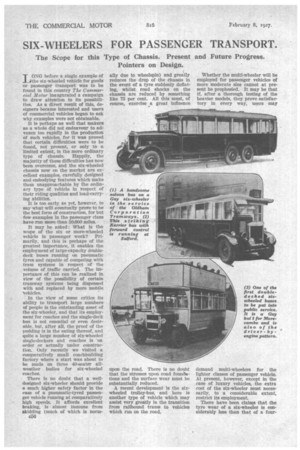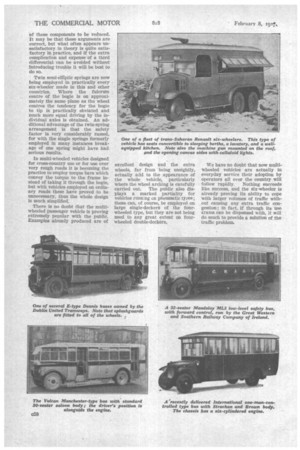SIX-WHEELERS FOR PASSENGER TRANSPORT.
Page 122

Page 123

Page 124

If you've noticed an error in this article please click here to report it so we can fix it.
The Scope for this Type of Chassis. Present and Future Progress. Pointers on Design.
TJONG before a single example of . the six-wheeled vehicle for goods or passenger transport was to be found in this country The Commercial Motor inaugurated a campaign to draw attention to its possibilities. As a direct result of this, designers became interested and users of commercial vehicles began to ask why examples were not obtainable.
It is perhaps as well that makers as a whole did not endeavour to advance too rapidly in the production of such vehicles, for it was proved that certain difficulties were to be found, not present, or only to a limited extent, in the more ordinary type of chassis. Happily, the majority of these difficulties has now been overcome, and the six-wheeled chassis now on the market are excellent examples, carefully designed and embodying features which make them unapproachable by the ordinary type of vehicle in respect of their riding qualities and load-carrying abilities.
It is too early as yet, however, to say what will eventually prove to be the best form of construction, for but few examples in the passenger class have run more than 10,000 miles.
It may be asked : What is the scope of the six or more-wheeled vehicle in passenger work? Primarily, and this is perhaps of the greatest importance, it enables the employment of large-capacity doubledeck buses running on pneumatic tyres and capable of competing with tram systems in respect of the volume of traffic carried. The importance of this can be realized in view of the possibility of certain tramway systems being dispensed with and replaced by more mobile Vehicles.
In the view of some critics its ability to transport large numbers of people is the outstanding asset of the six-wheeler, and that its employment for coaches and the single-deck bus is not essential or even desirable, but, after all, the proof of the pudding is in the eating thereof, and quite a large number of six-wheeled single-deckers and coaches is on order or actually under construction. Only recently we visited a comparatively small coachbuilding factory where a start was about to be made on three 40-seater allweather bodies for six-wheeled coaches.
There is no doubt that a welldesigned six-wheeler should provide a much higher safety factor in the case of a pneumatic-tyred passenger vehicle running at comparatively high speeds. It affords excellent braking, is almost immune from skidding (much of which is norm c56 ally due to wheelspin) and greatly reduces the drop of the chassis in the event of a tyre suddenly deflating, whilst road shocks on the chassis are reduced by something like 75 per cent. All this must, of course, exercise .0 great influence
upon the road. There is no doubt that the stresses upon road foundations and the surface wear must be substantially reduced.
A recent development is the sixwheeled trolley-bus, and here is another type of vehicle which may assist very greatly in the transition from railbonnd trams to vehicles which run on the road.
Whether the multi-wheeler will be employed for passenger vehicles of more moderate size cannot at present be prophesied. It may be that if, after a thorough testing of the heavier models, they prove satisfactory in every way, users may demand multi-wheelers for the lighter classes of passenger vehicle. At present, however, except in the case of luxury vehicles, the extra cost of the six-wheeler must necessarily, to a considerable extent, restrict its employment.
There have been claims that the tyre wear of a six-wheeler is considerably less than that of a four vheeler carrying similar loads, also hat the petrol consumption is educed, but really reliable figures rom actual users on these points re not yet available. It will reuire at least a year's running to rove whether these claims be Stisti.ed, although we are inclined to hink that in well-designed vehicles hey will be found to be true.
The progress already made has leen extremely rapid. Municipaliies in many parts of the country lave already ordered multi-wheelers. ieveral have actually put them into ervice. We may mention WolverLampton, Morecambe, Birmingham Lad Salford as typical examples.
So far only two British makers lave produced these large passenger aodels, these being Karrier Motors, Ad., of Huddersfield, and Guy dotors, Ltd., of Fallings Park, Wol-erhampton, but others have the natter in hand, and there is no' loubt that the Commercial Vehicle Cxhibition in November next will move a revelation to many visitors a this respect. Some of our makers lave-been-accused of neglecting the narket Nyhich apparently exists fer he multi-wheeler, but, as a matter If fact,, almost all of any importance the have not yet actually 'produced abdels are keeping a very careful .ye on the situation, and it may be that they will eventually make up the leeway. • It does not always do to rush into production, as is shown by the experience of several producers of six-wheelers in the 'United States. Out of the half a dozen or more makers who manufactured such vehicles only one or two have produced models which are being employed to any great extent. Some of the others were developed so hurriedly that they incorporated faults which proved a factor in retarding the progress of the six-wheeler, whereas if more care had been taken in design and the conditions studied more deeply a far greater number would probably now be in use there.
In an, editorial which we published last week we. referred at some length to the danger of limiting sixwheeler development by instituting regulations which might halt progress while the multi-wheeler is still immature. Nothing should be done which may tend adversely to affect future enterprise and the production of models which might incorporate many different features from those present in existing chassis. For instance, in the opinion of several prominent manufacturers wh,o have not yet produced sixwheelers but have them under consideration, it is advantageous to embody a differential between the
second and third axles—in other words, the two driving axles—but under the proposed regulations of the Ministry of Transport such a form of construction will necessitate the provision of two independent brake drums for each driving wheel, and with wheels equipped with pneumatic tyres such drums are extremely d,ifficult to fit. With the comparatively small wheel, and in the case of concentric drums, the inner one must not only be very Small, but is so shielded from air currents as to prevent the adequate distribution of the heat generated through braking. The alternative method of employing drums of the same diameter mounted side by side enforces the use of a narrow spring base, and so tends to increase rolling.
It is pointed out by those who believe in the bogie differential that where this is absent a one-inch difference in tyre radius due to unequal pressures or to wear results in 25 ft. of tyre slippage per mile; additional slippage would also occur when wheels go over humps or into pot-holes, owing to the greater distance of individual 'wheel travel, It is claimed by them that a differential will more than halve the stresses in axle shafts and gearing. so enabling the strength and weight!
of these components to be reduced. It may be that these arguments are correct, but what often appears unsatisfactory in theory is quite satisfactory in practice, and if the extra complication and expense of a third differential can be avoided without Introducing trouble it will be best to do so.
Twin semi-elliptic springs are now being employed in practically every six-wheeler made in this and other countries. Where the fulcrum centre of the bogie is on approximately the same plane as the wheel centres the tendency for the bogie to tip is practically obviated and much more equal driving by the individual axles is obtained. An additional advantage of the twin-spring arrangement is that the safety factor is very considerably raised, for with the single springs formerly employed in many instances breakage of one spring might have had serious results.
In multi-wheeled vehicles designed for cross-country use or for use over very rough roads it is becoming the practice to employ torque bars which convey the torque to the frame instead of taking it through the bogie, but with vehicles employed on ordinary roads these have proved to be unnecessary, thus the whole design is much simplified.
There is no doubt that the multiwheeled passenger vehicle is proving extremely popular with the public. Examples already produced are of excellent design and the extra wheels, far from being unsightly, actually add to the appearance of the whole vehicle, particularly where the wheel arching is carefully carried out. The public also displays a marked partiality for vehicles running on pneumatic tyres; these can, of course, be employed on large single-deckers of the fourwheeled type, but they are not being used to any great extent on fourwheeled double-deckers, We have no doubt that now multiwheeled vehicles are actually in everyday service their adoption by operators all over the country will follow rapidly. Nothing succeeds like success, and the six-wheeler is already proving its ability to cope with larger volumes of traffic without causing any extra traffic congestion; in fact, if through its use trams can be dispensed with, it will do much to provide a solution of the traffic problem.




































































































































































































